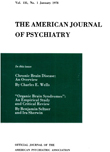THE ATARACTIC DRUGS: THE PRESENT POSITION OF CHLORPROMAZINE, FRENQUEL, PACATAL, AND RESERPINE IN THE PSYCHIATRIC HOSPITAL
Abstract
The ataractic drugs are so called from their ability to produce ataraxy: freedom from confusion and anxiety. In a veterans psychiatric unit of 550 beds with a high rate of admissions and discharges, chlorpromazine and reserpine have been intensively studied during the past 2 years and since June 1955, Frenquel has been given to 130 patients, and Pacatal to over 250, in an effort to clarify the indications for these ataraxics in the treatment of acute and chronic psychoses.
Our experiences with Frenquel are described in some detail as the originally hopeful and eventually disillusioning results obtained may explain many ambiguous findings in this complex field of research. Frenquel appears to have antihallucinatory and physically tonic effects in a small minority of regressed schizophrenics but to be of no value in the treatment of acute psychoses. Reserpine has also failed to fulfill earlier expectations. It is now reserved for the tranquillization of arteriosclerotics and as an adjuvant in the psychotherapy of some withdrawn schizophrenics.
Pacatal, a phenothiazine derivitive recently developed in Europe, and chlorpromazine are virtually interchangeable and synergistic. Pacatal is almost twice as strong a tranquillizer but a weaker hypnotic. It is mildly euphoriant and strongly parasympatholytic unlike chlorpromazine, a sympatholytic and depressant. Both are indicated in the symptomatic relief of psychomotor excitation, aggression, destructiveness, restlessness, and tension in acute and chronic psychoses. A combination of both, in which their mutually antagonistic autonomic effects reduce the incidence of complications and abolish the Parkinsonian syndrome, is yielding promising results.
In this study these drugs have significantly reduced the need for ECT and lobotomy without replacing these valuable methods of treatment. The seclusion of disturbed patients has been reduced to one-tenth. Since July 1955, insulin coma therapy has been replaced by group psychotherapy using ataraxics as adjuvants. Over twice the number of patients can be treated, so far with better results. Our discharges during 1955 outnumbered our admissions; the hospital atmosphere is calmer, and there is increased confidence and optimism. These latter factors cannot be ignored.
Alone, ataraxics merely modify symptoms but in conjunction with psychotherapy they open up wide vistas of therapeutic promise.
Access content
To read the fulltext, please use one of the options below to sign in or purchase access.- Personal login
- Institutional Login
- Sign in via OpenAthens
- Register for access
-
Please login/register if you wish to pair your device and check access availability.
Not a subscriber?
PsychiatryOnline subscription options offer access to the DSM-5 library, books, journals, CME, and patient resources. This all-in-one virtual library provides psychiatrists and mental health professionals with key resources for diagnosis, treatment, research, and professional development.
Need more help? PsychiatryOnline Customer Service may be reached by emailing [email protected] or by calling 800-368-5777 (in the U.S.) or 703-907-7322 (outside the U.S.).



